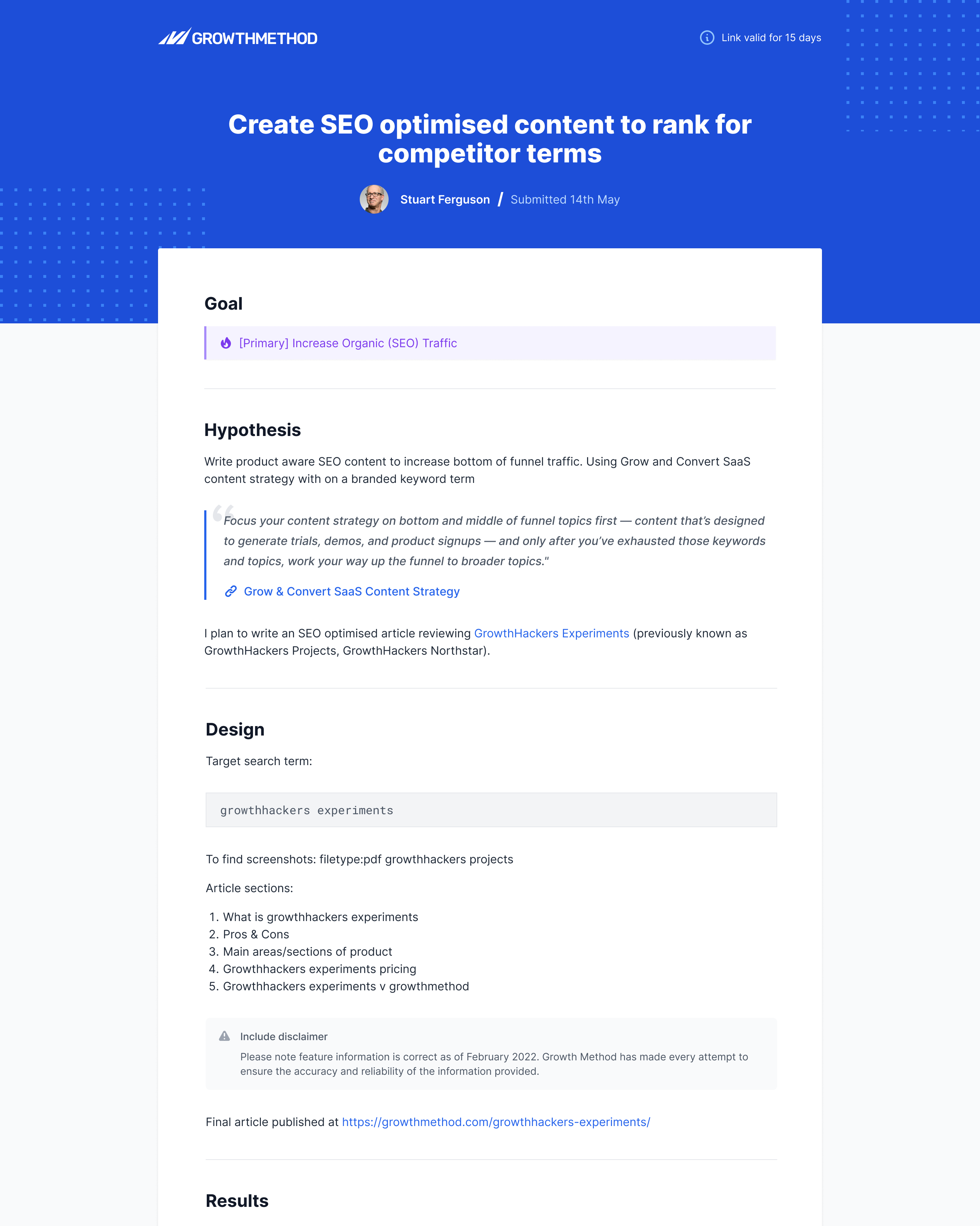Home / Principles /
7 Outside in v inside out
Article originally published in March 2024 by Stuart Brameld. Most recent update in April 2024.
Request a demo
Project management for growth and agile marketing professionals. Map your acquisition funnel, integrate analytics and run agile experiments.
Experiment results
Recent experiments results include competitor SEO, AI-driven content, exit-intent modals and AB testing homepage headlines.
Case study
"We are on-track to deliver a 43% increase in inbound leads this year. There is no doubt the adoption of Growth Method is the primary driver behind these results."
![]()
Certified
We are vetted mentors with Growth Mentor and a partner with the Agile Marketing Alliance.
A growth marketing strategy is a customer centric strategy
Understanding customers and representing their voice within your organisation is perhaps the most important job of a marketing team. The antithesis to the HiPPO marketing approach of “just listen to your manager” is customer development and “just listen to the customer.”
Deeply understanding your customer and your audience is the fuel to growth marketing and experimentation teams. Focusing on insights over execution will help your team understand:
- Which opportunities should be prioritised
- The potential impact on new ideas and opportunities
- How should we organise and structure our product portfolio
- What would be the most useful piece of content to create
- Which of the proposed ad messaging is most likely to resonate
Every on your team and in your company has opinions and bias, so a growth marketing strategy should include always-on user or customer research, often called “voice of customer”.
Customer centric
Being customer centric is about looking at marketing activities through the lens of the customer, not the lens of the business. Reducing focus on typical marketing metrics like MQLs, SQLs, pirate metric and the customer journey, and instead focusing on the emotional journey and value to the customer.
Customer-led growth, or customer-driven growth ensures the organisation continues thinks from the customer perspective – how does this add value to the customer, rather than how does this add value to the business.
| Business centric | Customer centric |
|---|---|
| Traffic, leads, MQLs & SQLs | Measuring customer value |
| The customer journey | The emotional journey of the customer |
| Business solutions | Customer problems |
| Marketing activity output | Marketing activity impact |
Get out of the building
“Get out of the building” is a cornerstone of Steve Blank’s Lean Startup methodology, which emphasises the importance of businesses understanding their customers and market through direct interaction, rather than relying solely on theoretical models or assumptions.
It is very easy to forget what it’s like to be a customer, and what it’s like to experience your website/product/app for the first time. You need to escape your own bias and assumptions, and the bias and assumptions of your team, colleagues and company.
Focus on discovering and understanding customer problems and use experimentation to find solutions. Let customers kill ideas, not opinion.
Jobs to be done
Jobs to be done is another excellent framework to start this approach. Whilst interviews are ideal, many teams start with running always-on surveys to people that have recently become new customers (in the last 3 to 6 months). In a world where data privacy is hot on the agenda, zero-party data collected directly from your audience is exactly the kind of qualitative data you should using to your advantage.
Specifically, you’ll want to ask customer questions such as:
- What life was like for you before you started using our product?
- What happened that made you realise “this isn’t working, I need something else”?
- What was your desired outcome?
- What were your must-haves / deal breakers?
- What did you do next, and next, and next … until you found us? (where did you go? who or what influenced your decisions?)
- What value did you see or experience that convinced you to pay for our solution?
- What led you to choose us over all the other options?
- What are you able to do now that you weren’t able to do before? How have you/your team evolved and grown since using our solution?
A natural curiosity around your user and customer behaviour also helps to avoid biases and internal opinions.
Quant and qual
Whilst rapid experimentation often provides lots of good data it should be paired with qualitative customer research to understand the “why” behind the data.
Data from Conversion.com also shows that a/b tests backed by qualitative research achieve better results in ab tests (in the dataset, experiments backed by evidence were winners 44.5% more often than those without it).
To summarise
Successful growth practitioners think first and foremost about delivering value to customers, not value to the organisation. Typically this means:
- Continually gathering new customer insights
- Seeking out information which challenges your beliefs and assumptions
- Creating value before extracting value
Remember ideas and experiments are a tool to prove or disprove something you believe about the customer, so they should always be mapped to how they help prospects or customers first (not how they provide value to you or your business). Aim to think customer, not company, first. Some practitioners like to use the phrase “customer value optimisation” rathe than “conversion rate optimisation”.
The more you understand your customers, the more effectively your acquisition channels are likely to perform. Your goal as a growth marketer is to continuous improvement based on real world insights and learnings.
Growth marketing strategy principles
-
1 Focus over diversification
“Our 2023 marketing strategy is to invest in Twitter organic, Linkedin paid ads, content marketing, SEO and email”. Some practitioners call this spray and pray marketing, Emily Kramer calls it random acts of marketing. Whatever you call it, this isn’t a growth marketing strategy, this is a list of random tactics and channels. The worst… Read more
-
2 Process over tactics
“Growth has nothing to do with tactics and has everything to do with process. Silver bullets don’t exist, you need a growth machine.” Brian Balfour Look inside many functions within a business – sales, finance, research & development, IT – there is often a process discipline that doesn’t exist in traditional marketing teams. Conversely, look… Read more
-
3 Always-on assets over one-off campaigns
Let’s run a campaign? No. Your growth marketing strategy should focus on building assets that can deliver compound growth over time. One-off marketing programs, initiatives and campaigns should be avoided at all costs. One-off marketing campaigns If you or your team do one-off activities, such as any of the following, stop now: No successful company has been… Read more
-
4 Impact over activity
A growth marketing strategy should prioritise impact over activity, which typically means being aligned to business revenue. At Growth Method we believe every marketing function should contribute to revenue and should should be part of the core revenue engine, alongside sales. “Position marketing as a strategic growth lever for the company. Know the math for… Read more
-
5 Data over opinions
A good growth marketing strategy uses data to guard against opinions, feelings, emotions and bias. With a combination of both quantitative and qualitative data growth teams can bring together the what and the why in order to make more informed decisions. Data should inform all aspects of your growth marketing programme including: Data-informed, not data-driven… Read more
-
6 Speed over perfection
A big part of marketing is getting something live, noticing how the market reacts, and then iterating to make it better based on what worked well (this process is the core tenant of the scientific method). That’s why following a regular cadence of launching new experiments is a critical step in improving everything about your… Read more
-
7 Outside in v inside out
A growth marketing strategy is a customer centric strategy Understanding customers and representing their voice within your organisation is perhaps the most important job of a marketing team. The antithesis to the HiPPO marketing approach of “just listen to your manager” is customer development and “just listen to the customer.” Deeply understanding your customer and… Read more


